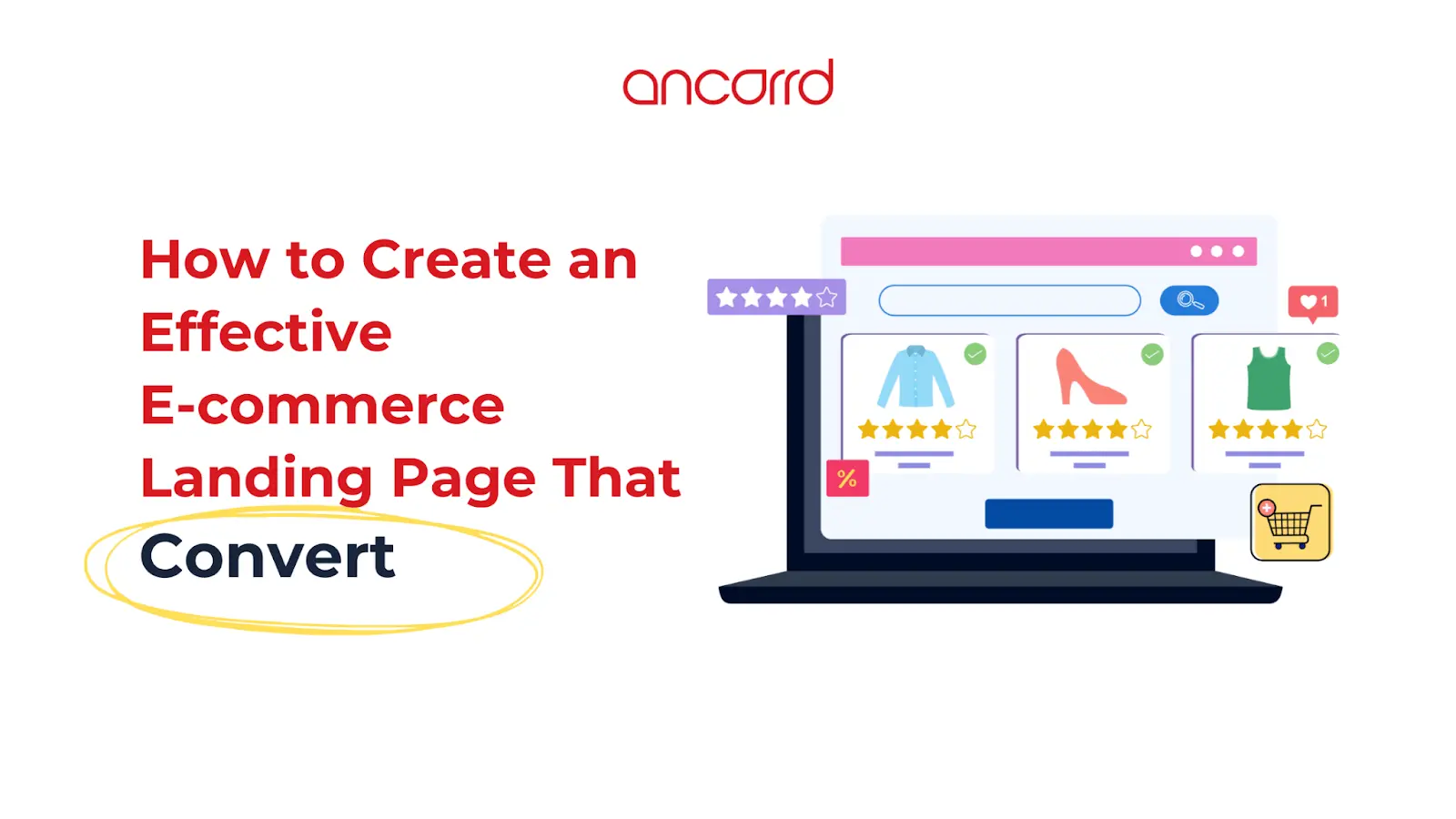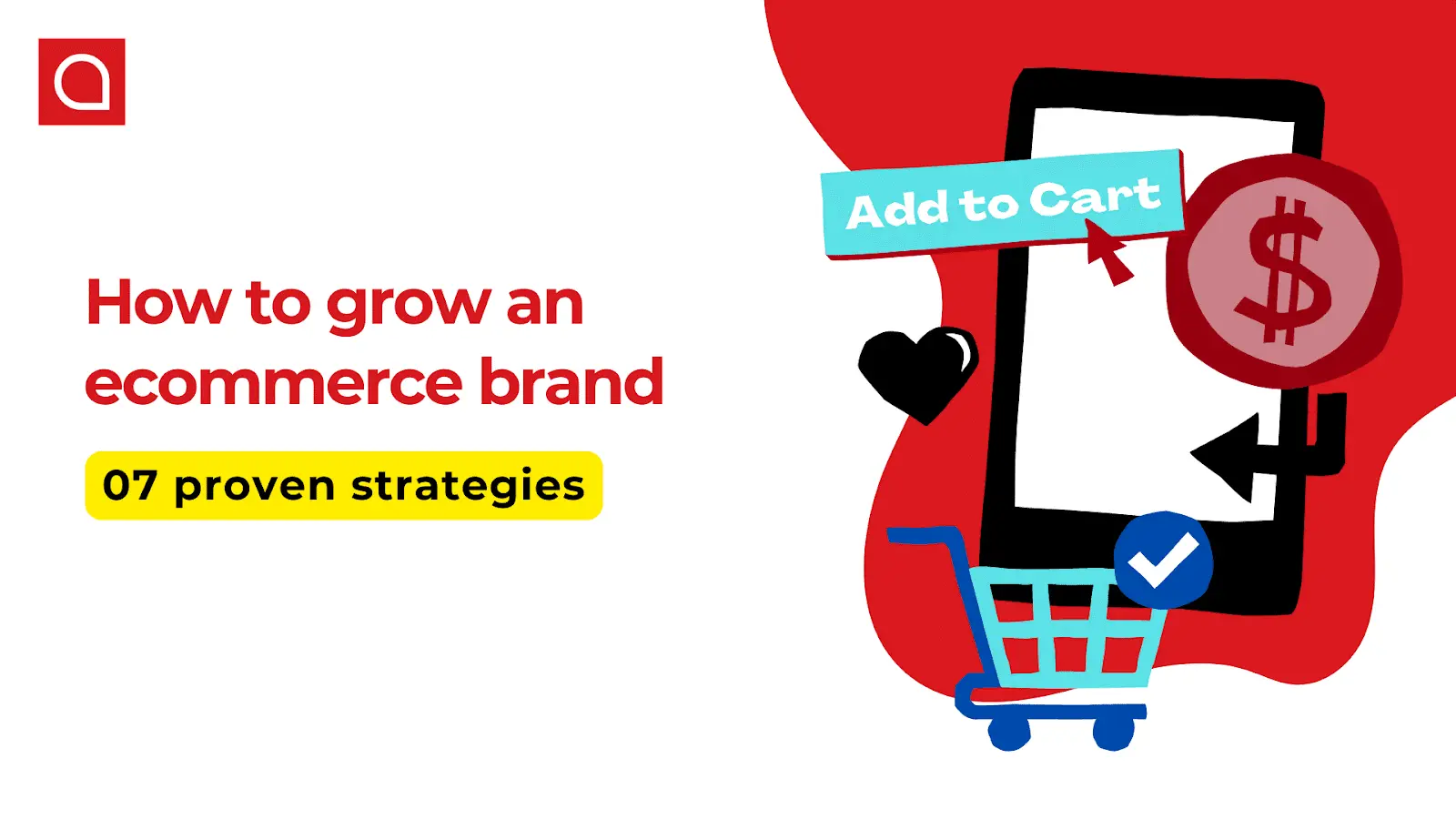It is exciting to know that, at the moment, e-commerce retail sales are around $8.1 trillion.
Everyone knows that the e-commerce market is highly dependent on search engines. People take their queries to search engines and expect it will provide the best solution. And you know what?
It is relatively accurate that search engines nowadays are advanced enough to deliver exact results to their users.
Whenever you search for a query on the search engine, you see a list of results on the first page. Notably, the top-ranking searches have a click-through rate(CTR) of 39.8%.
But how do search engines decide that a particular website should rank on the top page? Of course, this all depends on the SEO for e-commerce.
Every e-commerce business owner must have heard about SEO, but if you have not, don’t worry. I will give you the perfect SEO strategy for e-commerce. You will learn all about SEO, from defining SEO to various SEO strategies to run and optimize your online store.
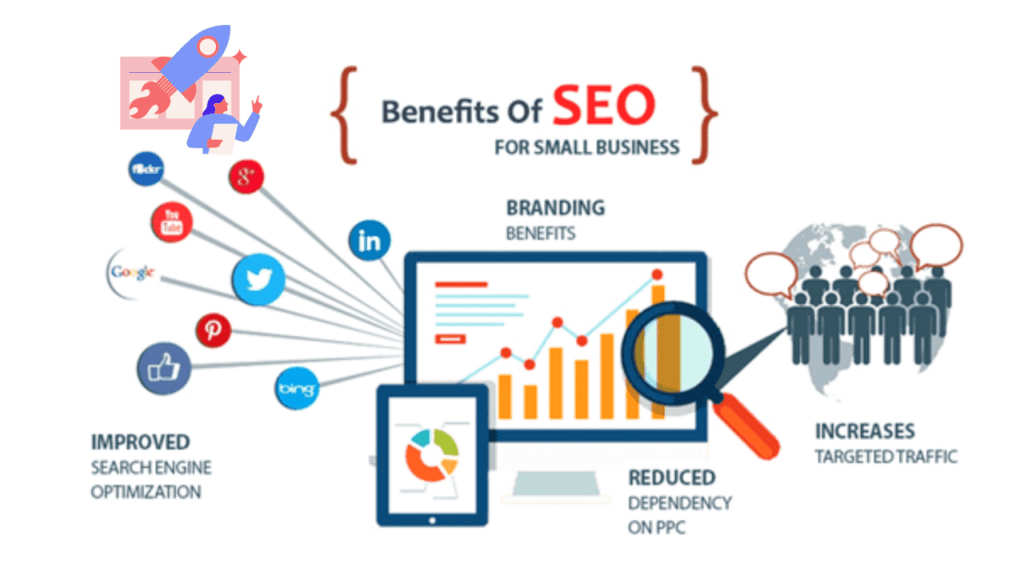
What is SEO for e-commerce?
SEO for e-commerce is the practice of optimizing an online store to increase its visibility on search engines. The ultimate goal is to attract organic or unpaid traffic from product pages, category pages, and other website sections as they appear higher in search engine results for relevant queries. SEO contains several different factors.
E-commerce SEO is not only about adding keywords to your website but is a completely technical process. You need to optimize your website according to the rules given by search engines.
The complexity of the e-commerce industry requires effective SEO so that a store ranks high in search results. This will increase the chances of reaching shoppers interested in similar products. Paid ads can only create traffic for you until your money runs out. E-commerce SEO will provide you with long-term value. Once you implement good SEO strategies, it will require no extra payment from you.
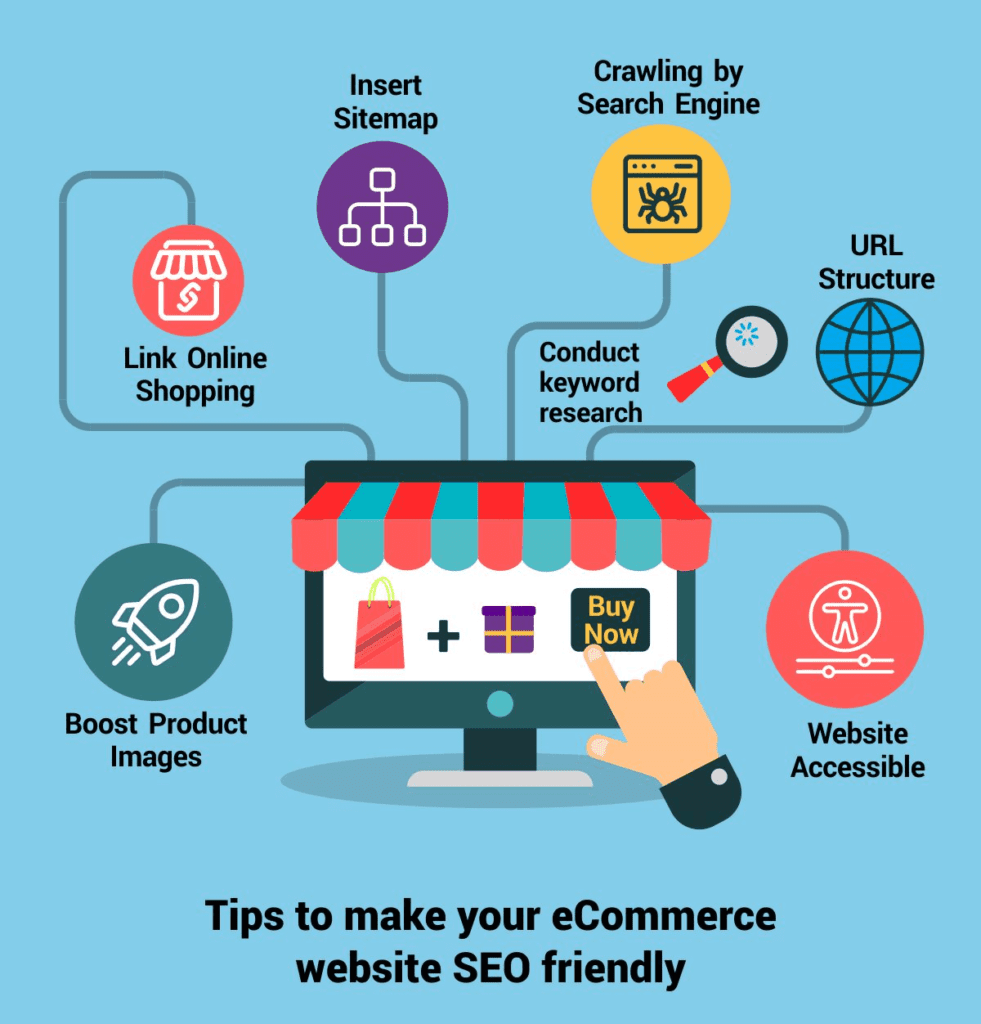
SEO Strategies
Below are some strategies that you can follow to implement SEO for E-commerce.
1- Conducting keyword research
SEO is nothing without keywords. Keywords help you to reach your target audience. Place yourself in your consumer’s shoes. For instance, if you want to buy a leather jacket for the upcoming season, you will write “best leather jackets.” This is the keyword.
Brands selling leather jackets online will use this keyword on their website and blogs, and when Google finds that a brand is targeting the same keyword, it will rank that website at the top. This is how keywords work for your E-commerce strategy.
Now, the question arises of where we can find the best keywords. You need to understand the people to find the best keywords that the public may use. For example, in November, people may search for “Christmas Leather Jackets” instead of the normal keyword. So, you need to understand the trends to determine the best keyword.

Another strategy is using search engine suggestions. As in the above image, you can see different keywords suggested by the search engine. This means that the people use these keywords. This is the best SEO strategy for E-commerce websites.
Some really useful keyword research tools that can help you find keywords are Ahrefs, Ubersuggest, Google keyword planner, and Semrush.
All these tools will provide you with a list of keywords. Their data is updated frequently, aligning with the latest trends. They also provide keyword density and volume( how many people search a certain term). You can also see which keywords your competitors use to rank on top pages.
Pro Tip:
Read comments and reviews of people on your or your competitor’s website to see which keywords people use to describe your product. This is an excellent SEO for e-commerce strategy.
2- Optimizing product pages
Product pages are the soul of your website. They appear in the search results whenever a customer searches for your product.
SEO for e-commerce includes optimizing product descriptions so that they contain the exact keywords. You should optimize your product description so that it conveys the meaning of the product and must contain the targeted keywords.
Your product images should be high quality. All the images must have alt text that conveys what is shown in the image. Keywords are preferred in the image alt text. This helps your images rank on Google and drive traffic.
Another aspect of E-commerce SEO is schema markup.
By using schema markup, you provide search engines with more valuable information, such as star ratings, price, availability, and reviews. The search engine then displays this information in rich snippets, which enhances the visual appeal of your content.

3- Building an SEO-friendly site framework
Site architecture or framework is a very important part of SEO for e-commerce. A smooth website structure attracts both customers and search engines.
When customers can easily find what they are looking for on your website, it becomes an advantage for you. Imagine clicking on a shoe image on a website, and the website takes you to a 404 error page. This frustrates users and causes customers to bounce to other websites.
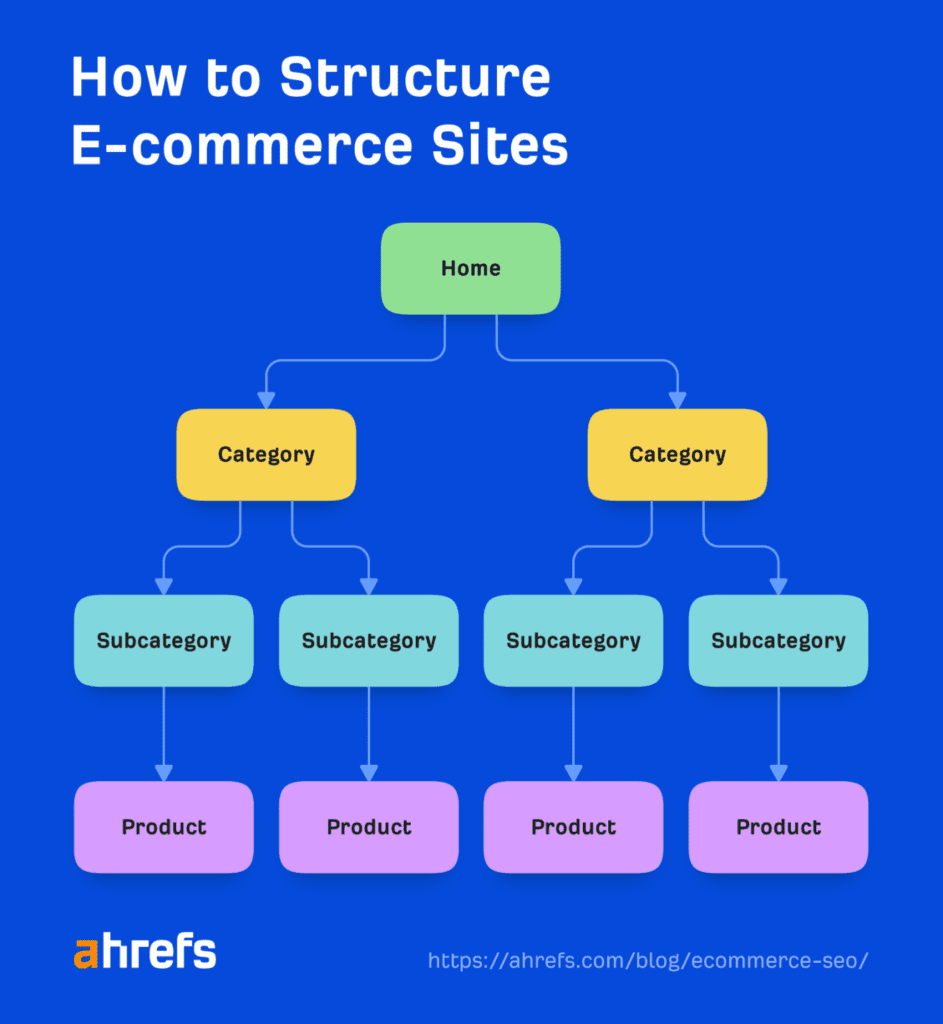
When search engines crawl through your website and find a smooth flow, they may rank your website. One way of e-commerce SEO is to arrange categories and sub-categories.
For instance, if your e-commerce store sells clothes, then make three categories: men, women, and kids. Then, make further subcategories like summer wear and winter wear, shoes, jackets, dresses, tuxedos, etc. to enhance your website.
Internal linking means linking product pages from your blogs to product pages. It increases website domain authority and is an excellent e-commerce strategy.
Pro tip:
The structure of the website should be clean and logical. Ideally, every page on your site would be no more than two clicks away from a click from your home page. This way, visitors can easily surf around your site, and the search engines can easily crawl your pages.

4- Improving mobile usability for enhanced user experience
45% of global consumers use their phones to shop online at least once daily. This shows that mobile optimization is essential for SEO for e-commerce nowadays. People like to shop on their mobile phones, but if the website is not responsive for mobile phones, it creates a terrible image.
A mobile-friendly website adjusts to each mobile screen without having customers zoom each time. Page optimization is also the best SEO strategy for E-commerce websites.
Websites that spend too much time loading on mobile have the greatest bounce rates. Research says that if your website takes 1 to 3 seconds to load, then the bounce rate increases to 32%. Stop this tragedy with your website and start optimizing it for mobile.
Google now uses “mobile-first indexing,” which means it will see your website’s mobile version. This point explains the importance of mobile-friendliness in SEO for e-commerce. If your website is suitable for mobiles, it will also be checked for desktops, PCs, etc.
Pro tip:
Use a responsive design that automatically adjusts to every size of the screen. Try your site on numerous devices to ensure it works well on mobile. Google favors sites that are mobile-friendly when ranking.
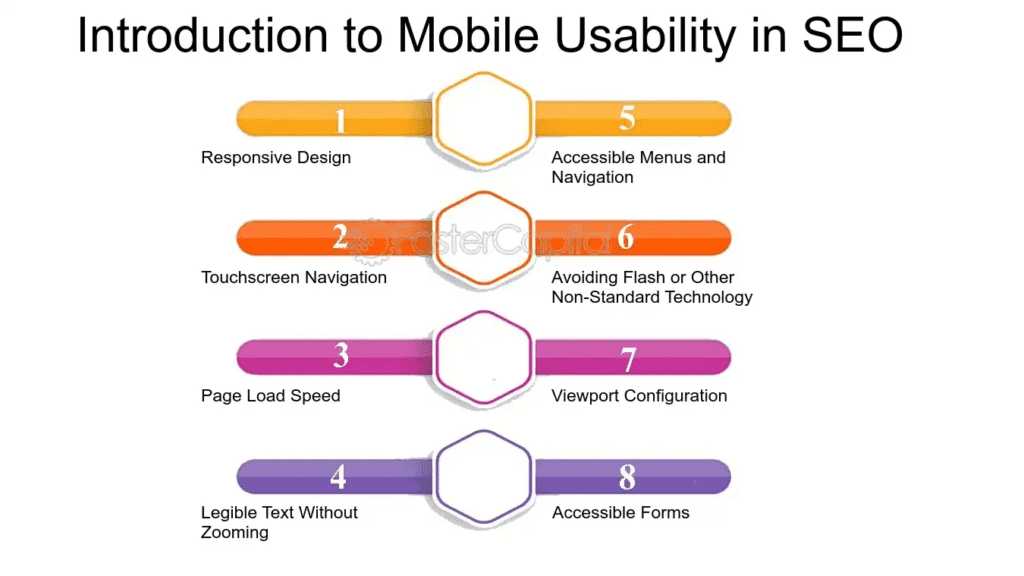
5- Building quality backlinks to boost domain authority
Backlinks are an important part of E-commerce SEO as they help build domain authority. It is like being referred to a job by a great university professor after completing your degree.
All other websites that have high domain authority and rank regularly on the search engine should add a link to your website. This will increase traffic and ensure the credibility of your website in the search engine.
But why will the top websites link to your website? You can solve this matter by posting guest posts on their website. Influencer outreach is another way of the best SEO strategy for e-commerce websites. In this social media era, people rely on their favorite influencers.
They trust their influencer’s choices and reviews and get products they recommend. When an influencer links any of your product pages in their stories, reels, or highlights, it increases traffic to your website.
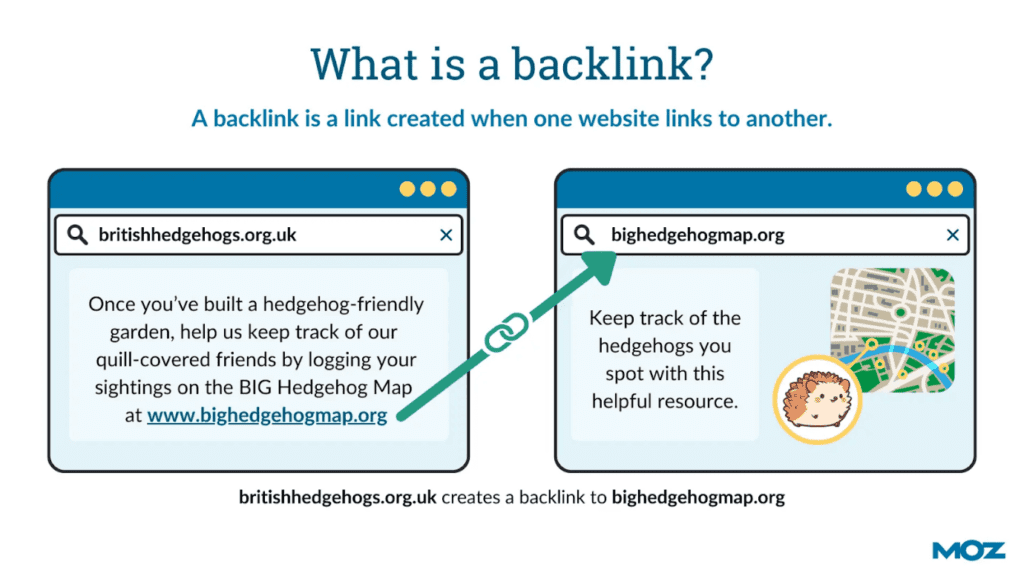
6- Optimizing for local SEO to target nearby customers
Local SEO will attract people in your region. You’ll likely get people seeking goods or services in your locality, especially if you have a physical store.
More than any other SEO for e-commerce, optimizing for local search will probably find people looking for goods or services in your locality.
This means that if a consumer close to you is looking for your product, your business’s chances of appearing in his search results improve, and the opportunities for local customers to find and go to your store increase.
Optimizing Google My Business
Optimizing Google My Business One way to enhance local visibility is by setting up a Google My Business listing. Here is a simple step-by-step guide:
Create a GMB Account: If you don’t already have an account, go to Google My Business and sign up for one.
- Fill in all the details: Fill in your business name, address, phone number, and website. Make sure all those match up with what’s on your website.
- Choose the right categories: Which categories would best describe your business to help Google match it up with the right kinds of searches?
- Add Photos: Add pictures of your store, products, or services. It will attract more locals to visit you.
- Requests Reviews: Ask happy customers to leave a review of your GMB listing because good reviews enhance credibility and rankings.
Local SEO is an important part of SEO for e-commerce if you want to reach local searchers. So, you need to add city or location-based keywords to your website.
For example, if your store is in Chicago, use phrases like “Chicago winter jackets” or “best coffee shop in Chicago” on product pages, blogs, or meta descriptions. Using location-specific keywords helps your website appear while people nearby seek products similar to what you sell, increasing their likelihood of finding you and coming to your store.

Implementing technical SEO best practices
There are different steps for implementing technical SEO on your website. This is a perfect SEO for an e-commerce strategy. It makes the flow of your website easy and simple for search engines to crawl. Utilize tools such as XML sitemaps, robots.txt, and canonical tags to make it easier for search engines to crawl and understand the structure of your website:
- XML Sitemaps: This is a map of your site that presents all the pages to the search engines. Submitting an XML sitemap of your site in the search engines makes it easy to find and index each page on your site.
- Robots.txt: This file informs search engines which parts of your site they should and should not crawl. It’s useful for keeping search engines concentrated on your main pages and skipping the unnecessary ones.
- Canonical Tags: These tags will inform search engines which page in a set of similar or duplicate pages created is the “main.” Search engines will give all attention to those main pages.
Ultimately, your website should be switched to HTTPS (with SSL) for both SEO for e-commerce and user confidence. HTTPS means that your site is secure, safeguarding visitor information and entrusting it to them while they’re on it.
Search engines like Google prefer secure sites, which can boost your ranks. Furthermore, users will spend more time and shop more on a site that they feel is secure; hence, HTTPS must become a compulsory necessity for every e-commerce success.
Pro tip:
Find broken links often and optimize page speed to upgrade your XML sitemap with every new post. Technical processes for getting search engines to crawl and index your site bring high SEO.
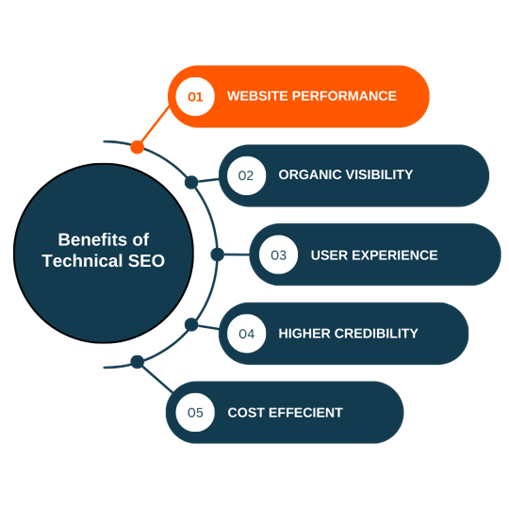
Conclusion
In the above blog, we focused on different strategies that highlight the importance of SEO for E-commerce. Search engines are so important in today’s shopping era that it is very important to optimize your website according to their rules.
From keyword research to mobile responsiveness and technical SEO, every factor matters in the ranking of your e-commerce website.
Subscribe to our weekly newsletter to get crispy CRO tips and marketing strategies that win millions of qualified leads with minimal marketing spend.
FAQs
-
What is eCommerce SEO?
SEO for e-commerce is the practice of optimizing an online store to increase its visibility on search engines. The ultimate goal is to attract organic or unpaid traffic from product pages, category pages, and other sections of the website as they appear higher in search engine results for relevant queries. SEO contains several different factors.
-
What is the SEO strategy for an eCommerce website?
Because search engines are so important in today’s shopping era, it is very important to optimize your website according to search engines’ rules. From keyword research to mobile responsiveness and technical SEO, every factor matters in the ranking of your e-commerce website.
-
What are the best tools for eCommerce SEO?
Some really useful keyword research tools that can help you find keywords are Ahrefs, Ubersuggest, Google keyword planner, and Semrush. All these tools will provide you with a list of keywords. Their data is updated frequently, aligning with the latest trends. They also provide you with keyword density and volume( how many people search a certain term). You can also see which keywords your competitors are using to rank on top pages.
-
What is a backlinking strategy?
Backlinks are an important part of E-commerce SEO as they help build domain authority. It is like being referred to a job by a great university professor after completing your degree. All other websites that have high domain authority and rank regularly on the search engine should add a link to your website. This will increase traffic and ensure the credibility of your website in the search engine.
-
What is a local SEO?
Local SEO will attract people in your region. You’ll likely get people seeking goods or services in your locality, especially if you have a physical store. More than any other SEO for e-commerce, if you are optimizing for local search, you’ll probably find that people are looking for goods or services in your locality.


